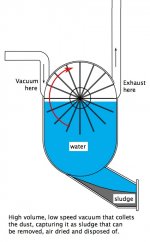herrmc
Plastic
- Joined
- Feb 13, 2012
- Location
- USA, Oklahoma
I would like to build a small sandblaster that would have at least one fixed nozzle, mabye several.
the general idea would me that there would be a small chamber, no need for gloves or view sheild, with very small openings on each end where either solid material, or tubing (small diameter) could be passed through slowly getting blasted from different angles. Maybe working with a power feeder... feeding through slowly is fine (no need for speed)... but want consistency.
The desired objective is to feed 20 ft pieces of material through and remove the mill scale. I figure first of all, someone may have already tried this.... But the main thing I am wondering about is the specifics of building the nozzles, and the different parts required.... I figured to use the carbide nozzles... but maybe the ceramic... I was thinking since it was going to be fixed nozzles that there would be no need for the traditional gun... curious about the size of the pipe used, and orifice requirement... Could it be as simple as taking a .5" Black metal TEE and .... Air in one side... Nozzle on the other, and suck media from the bottom? .... I assume a street type TEE would work better... but would a regular TEE work good enough?
Thanks in advance for any constructive input!
the general idea would me that there would be a small chamber, no need for gloves or view sheild, with very small openings on each end where either solid material, or tubing (small diameter) could be passed through slowly getting blasted from different angles. Maybe working with a power feeder... feeding through slowly is fine (no need for speed)... but want consistency.
The desired objective is to feed 20 ft pieces of material through and remove the mill scale. I figure first of all, someone may have already tried this.... But the main thing I am wondering about is the specifics of building the nozzles, and the different parts required.... I figured to use the carbide nozzles... but maybe the ceramic... I was thinking since it was going to be fixed nozzles that there would be no need for the traditional gun... curious about the size of the pipe used, and orifice requirement... Could it be as simple as taking a .5" Black metal TEE and .... Air in one side... Nozzle on the other, and suck media from the bottom? .... I assume a street type TEE would work better... but would a regular TEE work good enough?
Thanks in advance for any constructive input!


